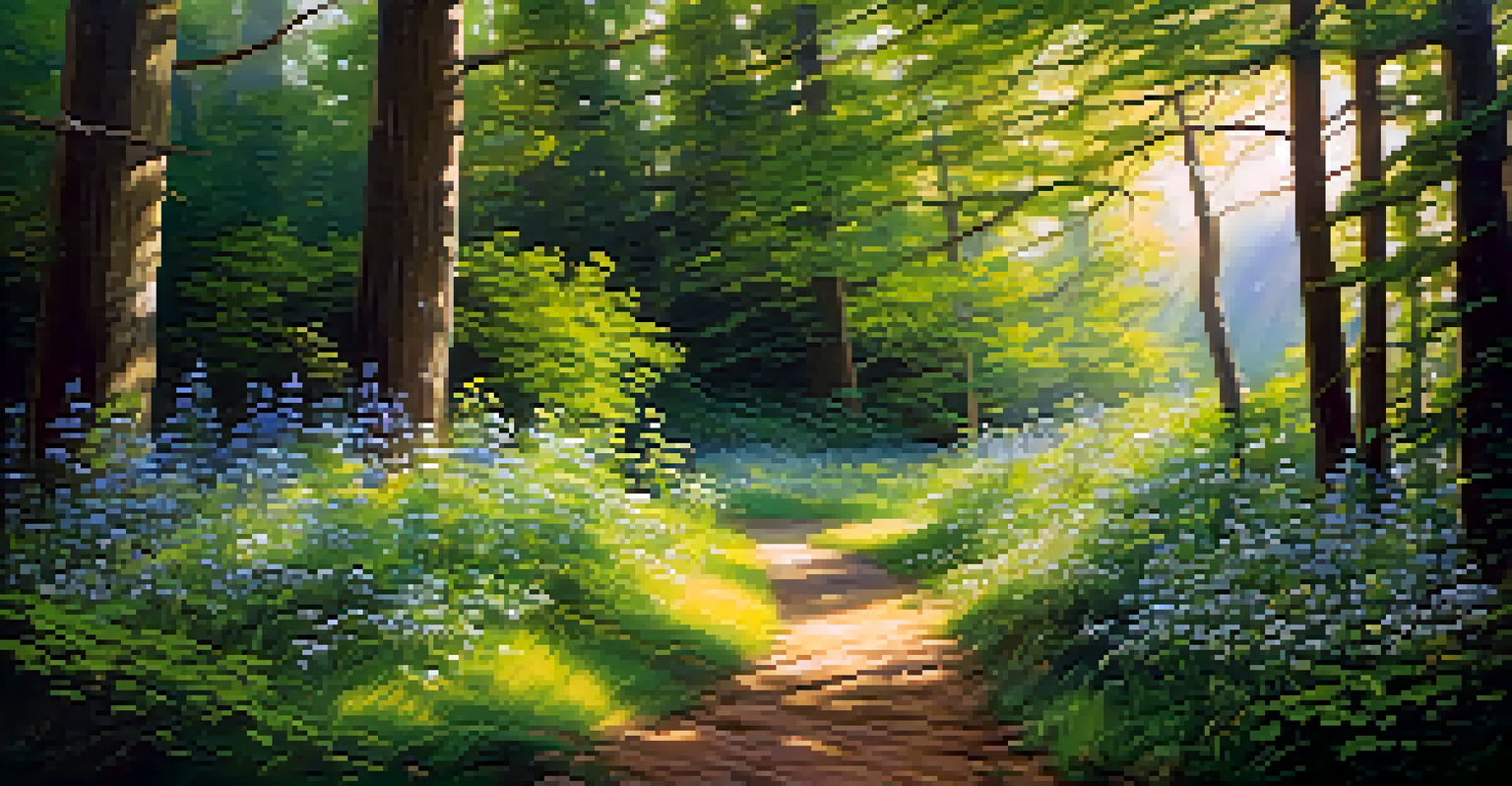The Impact of Transcendentalism on Romantic Landscape Art

Understanding Transcendentalism and Its Origins
Transcendentalism emerged in the early 19th century as a philosophical movement that emphasized the inherent goodness of people and nature. Rooted in European Romanticism, it sought to transcend the limitations of traditional thought and materialism. Key figures like Ralph Waldo Emerson and Henry David Thoreau championed individual intuition and the spiritual connection to nature.
In every work of art the spirit of the age is reflected.
This movement encouraged artists and writers to explore their thoughts and emotions, fostering a deeper relationship with the natural world. By viewing nature as a source of inspiration and insight, Transcendentalists laid the groundwork for new artistic expressions. This revolutionary mindset challenged conventional norms and welcomed a more personal approach to art.
In this context, artists began to depict landscapes not just as physical spaces but as reflections of human emotion and spiritual experience. The movement's core ideas resonated with the Romantic artists, who sought to capture the sublime beauty of nature, ultimately transforming the landscape genre.
Romanticism: A Brief Overview of the Movement
Romanticism was an artistic and intellectual movement that flourished in the late 18th and early 19th centuries, focusing on emotion, nature, and individualism. It arose as a reaction against the rationalism of the Enlightenment and the industrial revolution's mechanization of life. Romantic artists and writers sought to emphasize personal experience and the beauty of the natural world.

In art, this meant creating works that evoke strong feelings through dramatic landscapes, vivid colors, and imaginative scenes. Romantic painters like Caspar David Friedrich and J.M.W. Turner captured the emotional resonance of nature, often portraying it as a force that could inspire awe and introspection. Their work emphasized the sublime, a concept that refers to beauty that simultaneously inspires fear and pleasure.
Transcendentalism's Roots in Emotion
Transcendentalism emphasizes the inherent goodness of people and nature, encouraging a deep emotional and spiritual connection with the natural world.
By intertwining emotion with nature, Romanticism paved the way for a profound exploration of the human spirit. The movement's focus on individual experience and the emotional connection to nature aligns closely with the principles of Transcendentalism, creating a fertile ground for artistic development.
The Convergence of Transcendentalism and Romantic Art
The intersection of Transcendentalism and Romanticism created a unique artistic landscape where emotion and spirituality flourished. Both movements valued personal experience and the deep connection to nature, leading artists to explore these themes in their work. This convergence allowed for a rich dialogue between philosophy and art, resulting in powerful visual narratives.
I believe that water is the only drink for a wise man; wine is not so noble a liquor.
Artists began to reflect the Transcendentalist belief in the spiritual essence of nature, often depicting landscapes as more than mere scenery. Instead, these works became portals for viewers to experience the divine and transcendental aspects of the world around them. For instance, artists like Thomas Cole infused their landscapes with moral and philosophical themes, inviting viewers to ponder their own relationship with nature.
The blending of these ideas not only transformed artistic techniques but also expanded the emotional depth of landscape art. As artists sought to convey the sublime experience of nature, they embraced a more subjective and introspective approach, echoing the core tenets of Transcendentalism.
Influential Artists of the Time
Several key artists emerged during this period, whose works exemplified the fusion of Transcendentalism and Romanticism. Caspar David Friedrich, a German Romantic painter, is renowned for his evocative landscapes that often feature solitary figures contemplating nature's grandeur. His works invite viewers to reflect on their own existence and connection to the universe.
Another notable figure is Thomas Cole, considered the founder of the Hudson River School. Cole's paintings celebrated the American landscape while embodying Transcendentalist ideals. His works often portrayed nature as a sanctuary for the soul, inspiring viewers to appreciate the beauty and spiritual significance of the natural world.
Romanticism's Impact on Art
Romanticism's focus on individualism and emotional expression paved the way for artists to explore profound themes in their landscape works.
These artists, along with others like Frederic Edwin Church, used their art to convey profound messages about humanity's relationship with nature. Their ability to blend emotion, philosophy, and stunning visuals marked a significant evolution in landscape art, showcasing the lasting impact of Transcendentalism.
Key Themes in Romantic Landscape Art
Romantic landscape art is characterized by several key themes, many of which align with Transcendentalist beliefs. One prominent theme is the portrayal of nature as a source of inspiration and enlightenment. Artists often depicted vast, untamed landscapes that evoke a sense of wonder and introspection, encouraging viewers to connect with their surroundings and contemplate their existence.
Another recurring motif is the sublime, a concept that evokes feelings of awe and reverence in the face of nature's beauty. This theme reflects the Transcendentalist idea that nature holds profound spiritual truths. Artists captured dramatic scenes, such as towering mountains or turbulent seas, illustrating the emotional power of these natural elements.
Additionally, many Romantic landscapes convey a sense of solitude and introspection, inviting viewers to reflect on their own thoughts and emotions. This focus on the individual experience aligns closely with Transcendentalist ideals, emphasizing the importance of personal connection to the natural world.
The Legacy of Transcendentalism in Art
The influence of Transcendentalism on Romantic landscape art has left a lasting legacy that continues to resonate today. The movement encouraged artists to explore deeper emotional and spiritual connections with their subjects, pushing the boundaries of traditional art. This approach paved the way for modern art movements that prioritize individual expression and subjective experience.
Moreover, the themes of nature and introspection remain relevant in contemporary art, as many artists draw inspiration from the natural world. The emphasis on personal connection to nature and the exploration of the sublime continue to be key elements in artistic expression. Today's artists often reflect on the environment, urging viewers to consider their relationship with the world around them.
Legacy of Nature in Art
The fusion of Transcendentalism and Romanticism has left a lasting legacy, shaping modern artistic expressions that prioritize personal connections to nature.
Ultimately, Transcendentalism's impact on Romantic landscape art has shaped not only the way we perceive art but also our understanding of ourselves in relation to nature. This enduring legacy serves as a reminder of the power of art to inspire contemplation and foster a greater appreciation for the beauty that surrounds us.
Conclusion: Transcendentalism's Enduring Influence on Art
In conclusion, the intertwining of Transcendentalism and Romantic landscape art marked a significant evolution in the artistic landscape of the 19th century. By emphasizing the emotional and spiritual connections to nature, these movements transformed landscapes into powerful expressions of human experience. Artists like Caspar David Friedrich and Thomas Cole exemplified this fusion, creating works that continue to inspire reflection and awe.
The themes of nature, the sublime, and individual introspection resonate deeply with audiences, reminding us of our own connections to the world around us. As we navigate the complexities of modern life, the messages inherent in this art remain relevant, encouraging us to seek solace and inspiration in nature.

Ultimately, the legacy of Transcendentalism in Romantic landscape art invites us to appreciate not only the beauty of our surroundings but also the deeper truths they may reveal about our existence. This enduring influence serves as a reminder that art can transcend time, connecting us to the wisdom of the past while inspiring future generations.